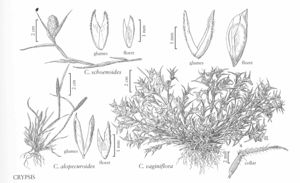Difference between revisions of "Crypsis alopecuroides"
FNA>Volume Importer |
FNA>Volume Importer |
||
| Line 7: | Line 7: | ||
|synonyms={{Treatment/ID/Synonym | |synonyms={{Treatment/ID/Synonym | ||
|name=Heleochloa alopecuroides | |name=Heleochloa alopecuroides | ||
| − | |authority= | + | |authority= |
| + | |rank=species | ||
}} | }} | ||
|hierarchy=Poaceae;Poaceae subfam. Chloridoideae;Poaceae tribe Cynodonteae;Crypsis;Crypsis alopecuroides | |hierarchy=Poaceae;Poaceae subfam. Chloridoideae;Poaceae tribe Cynodonteae;Crypsis;Crypsis alopecuroides | ||
| Line 20: | Line 21: | ||
-->{{Treatment/Body | -->{{Treatment/Body | ||
|distribution=Colo.;Wash.;B.C.;Utah;Calif.;Mont.;Oreg.;Pa.;Wyo.;Idaho;Nev. | |distribution=Colo.;Wash.;B.C.;Utah;Calif.;Mont.;Oreg.;Pa.;Wyo.;Idaho;Nev. | ||
| − | |discussion=<p>Crypsis alopecuroides is common to abundant in sandy soils around drying lake margins in Oregon and southern Washington, and within the last forty years has become widespread in northern California; it is also known from several other western states. It was first collected in the Western Hemisphere in the late 1800s from shipyard areas in and around Philadelphia, but has not been collected in the eastern United States since. In the Eastern Hemisphere, it extends from France and northern Africa to the Urals and Iraq.</p> | + | |discussion=<p><i>Crypsis alopecuroides</i> is common to abundant in sandy soils around drying lake margins in Oregon and southern Washington, and within the last forty years has become widespread in northern California; it is also known from several other western states. It was first collected in the Western Hemisphere in the late 1800s from shipyard areas in and around Philadelphia, but has not been collected in the eastern United States since. In the Eastern Hemisphere, it extends from France and northern Africa to the Urals and Iraq.</p> |
|tables= | |tables= | ||
|references= | |references= | ||
| Line 29: | Line 30: | ||
-->{{#Taxon: | -->{{#Taxon: | ||
name=Crypsis alopecuroides | name=Crypsis alopecuroides | ||
| − | |||
|authority=(Piller & Mitterp.) Schrad. | |authority=(Piller & Mitterp.) Schrad. | ||
|rank=species | |rank=species | ||
| Line 36: | Line 36: | ||
|basionyms= | |basionyms= | ||
|family=Poaceae | |family=Poaceae | ||
| − | |illustrator=Linda A. Vorobik | + | |illustrator=Linda A. Vorobik;Karen Klitz |
| + | |illustration copyright=Utah State University | ||
|distribution=Colo.;Wash.;B.C.;Utah;Calif.;Mont.;Oreg.;Pa.;Wyo.;Idaho;Nev. | |distribution=Colo.;Wash.;B.C.;Utah;Calif.;Mont.;Oreg.;Pa.;Wyo.;Idaho;Nev. | ||
|reference=None | |reference=None | ||
| Line 42: | Line 43: | ||
|publication year= | |publication year= | ||
|special status= | |special status= | ||
| − | |source xml=https:// | + | |source xml=https://jpend@bitbucket.org/aafc-mbb/fna-data-curation.git/src/f50eec43f223ca0e34566be0b046453a0960e173/coarse_grained_fna_xml/V25/V25_697.xml |
|subfamily=Poaceae subfam. Chloridoideae | |subfamily=Poaceae subfam. Chloridoideae | ||
|tribe=Poaceae tribe Cynodonteae | |tribe=Poaceae tribe Cynodonteae | ||
Revision as of 21:37, 16 December 2019
Culms (3)5-75 cm rarely branched above the base. Sheaths glabrous; collars glabrous; ligules 0.2-1 mm; blades 5-12 cm long, 1.2-2.5 mm wide, not disarticulating. Panicles 1.5-6.5 cm long, 4-6 mm wide, 7-8 times longer than wide, often purplish, completed exserted from the uppermost sheath at maturity on peduncles at least 1 cm long. Spikelets 1.8-2.8 mm, remaining lightly attached until late in the season. Lower glumes 1.2-2 mm; upper glumes 1.4-2.4 mm; lemmas 1.7-2.8 mm; paleas faintly 2-veined; anthers 3, 0.5-0.6 mm. Caryopses 0.9-1.1 mm. 2n = 16.
Distribution
Colo., Wash., B.C., Utah, Calif., Mont., Oreg., Pa., Wyo., Idaho, Nev.
Discussion
Crypsis alopecuroides is common to abundant in sandy soils around drying lake margins in Oregon and southern Washington, and within the last forty years has become widespread in northern California; it is also known from several other western states. It was first collected in the Western Hemisphere in the late 1800s from shipyard areas in and around Philadelphia, but has not been collected in the eastern United States since. In the Eastern Hemisphere, it extends from France and northern Africa to the Urals and Iraq.
Selected References
None.
